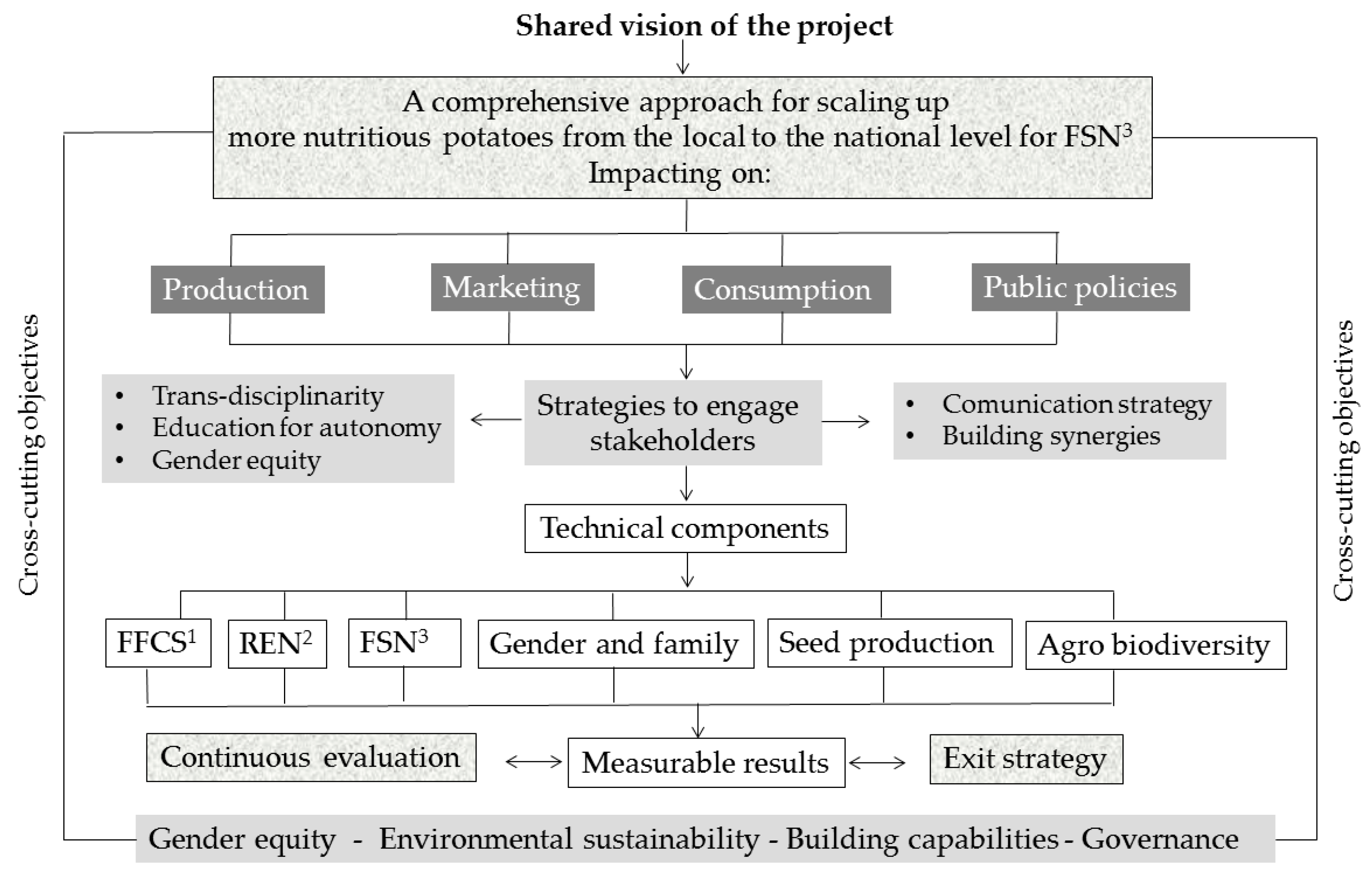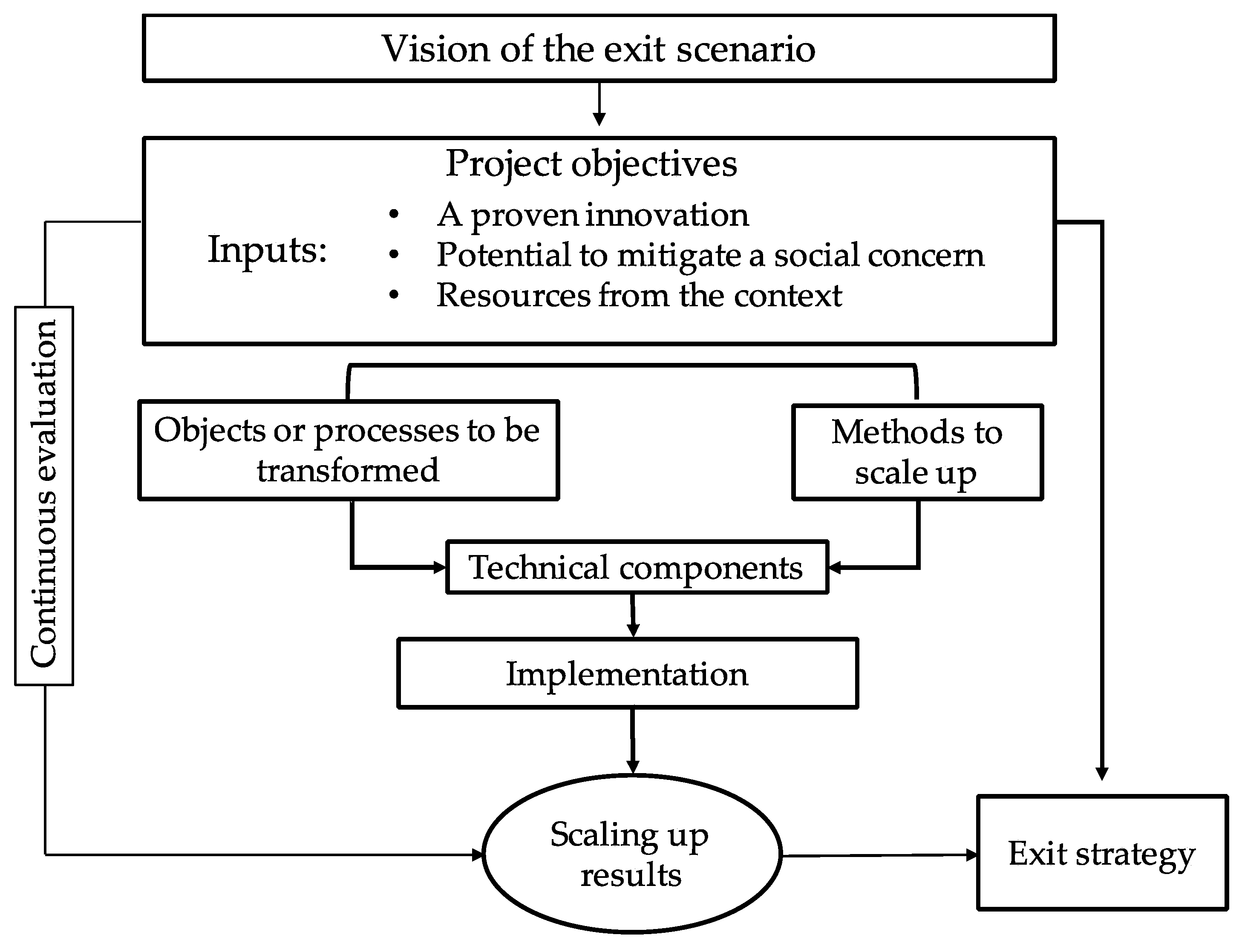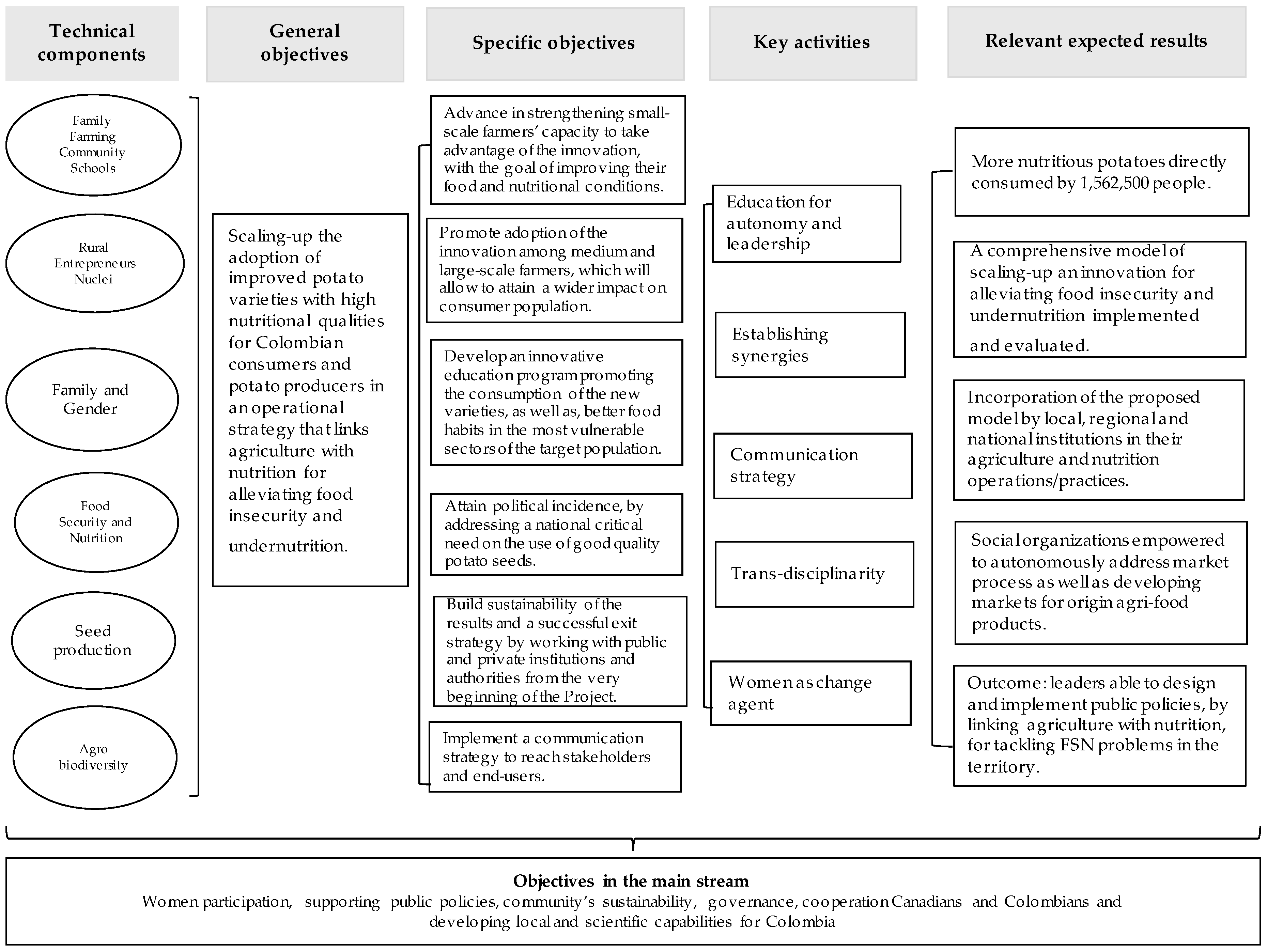A Model to Promote Sustainable Social Change Based on the Scaling up of a High-Impact Technical Innovation
Abstract
1. Introduction
2. Methodology
2.1. Design of the Scaling up Model
2.2. The Case More Nutritious Potatoes Project
2.2.1. Research Territories for Implementing the Model
2.2.2. Technological Innovation
2.2.3. Social Innovations
3. Results
3.1. Key Elements for the Scaling up Model
3.1.1. A Vision of the Exit Scenario
3.1.2. Clear Scaling up Objectives
3.1.3. Coherence among Objectives, Processes, and Situations to Be Transformed
3.1.4. Methods for Scaling up and Strategies to Involve Stakeholders
3.1.5. Technical Components
3.1.6. Trans-Disciplinary Implementation
3.1.7. Exit Strategy
3.1.8. Continuous Evaluation
3.2. Key Elements in Scaling up the More Nutritious Potatoes Project
3.2.1. Guidelines for Scaling up the Innovation
- Having a good solution: technology, method, or practice that has a strong science behind it. This is robust enough to perform in different conditions and can be easily adapted to local practices. In order to be able to develop such a good solution, local know-how needs to be incorporated. The research to be conducted is user-inspired. Focus on women instead of focusing on the number of women participating in the project, it is necessary to move to more qualitative indicators such as gender role, empowerment, decision making. The incorporation of the youth is also crucial.
- Right business model for scaling up: in order for an innovation to reach a large number of farmers, men, and women, it has to be affordable and easy to implement without too intensive processes.
- The right partners help to co-develop, together with the researcher and the farmer’s effective and practical business model to work in the reality. Those key partners are policy actors that enable the environment for scaling up, civil organizations reaching the local population, non-traditional actors, such as the private sector, meaning individual entrepreneurs or small enterprises within the country of intervention, like food processors, seed distributors, farmer associations, and cooperatives. It is necessary to develop a common language and common tools to work with different actors. The involvement of students is important as they are the leaders of the future. Students who are excellent in their fields and know how to communicate with people in other disciplines and with non-academics must become actors as well.
- Need to read/interpret the local context and to take advantage of the existing opportunities. Scaling up is not a straightforward process, it is needed to have the local conditions and factors. Very often scaling up depends on luck.
- Importance of leadership in the long-term. Scaling up is not a process that requires long-term funding, but funding is not the key challenge. The most important and harder thing to get is the commitment over the long-term as it can take the innovation beyond time and geographical barriers of the project.
3.2.2. The Vision of the Exit Scenario of the Project More Nutritious Potatoes
3.2.3. Definition of the Scaling up Objectives
3.2.4. What Should Change: Comprehensive Approach for Scaling up
3.2.5. How to Involve Different Actors: Strategies to Engage Stakeholders
3.2.6. Technical Components
3.2.7. Achieving Relevant and Measurable Results
3.2.8. Sustainability: Exit Strategy
3.2.9. Continuous Evaluation
4. Discussion
4.1. The Scaling up Model Responds to a Complex Problem
4.1.1. The Exit Scenario a Powerful Tool
4.1.2. Clear Scaling up Objectives Requires the Expertise of the Team Members
4.1.3. Each Stakeholder Requires Special Treatment for Their Participation
4.1.4. Trans-Disciplinary Implementation through Technical Components
4.1.5. Exit Strategy Is Built from the Beginning of the Project
4.1.6. Continuous Evaluation a Strategy to Keep a Unified Whole
4.2. The More Nutritious Potatoes Project Integrates Successfully a Technological Innovation with Social Change
4.2.1. Basic Guidelines for Scaling up Projects
4.2.2. The Vision of the Exit Scenario Invites Clarification of the Institutional Ethical Parameters
4.2.3. Definition of the Scaling up Objectives
4.2.4. “What Should Change” Requires a Comprehensive Approach for Scaling up
4.2.5. Defining Strategies to Engage Stakeholders Is a Fundamental Task
4.2.6. Synergies Are Important Input
4.2.7. Education to Build Autonomy Is Basic for Social Change in Paternal Cultures
4.2.8. RRR Strategy Increased Gender Equity
4.2.9. A Communication Strategy Should Consider Local and Regional Conditions
4.2.10. Technical Components Are Based on Robust Specialties Sensible to the Scaling Project Objectives
4.2.11. Monitoring Results Should Be Based on Trust and Commitment
4.2.12. Involving Local Institutions Is Basic for Exit Strategy
4.2.13. The Basis of Continuous Evaluation Are Indicators Defined by Technical Components
5. Conclusions
Author Contributions
Funding
Acknowledgments
Conflicts of Interest
References
- Rivera, W.M.; Qamar, M.K.; Crowder, L.V. Agricultural and Rural Extension Worldwide: Options for Institutional Reform in the Developing Countries; FAO: Rome, Italy, 2001. [Google Scholar]
- Gilligan, D.O. Biofortification, agricultural technology adoption, and nutrition policy: Some lessons and emerging challenges. CESifo Econ. Stud. 2012, 58, 405–421. [Google Scholar] [CrossRef]
- Menter, H.; Kaaria, S.K.; Johnson, N.L.; Ashby, J.A. Scaling up. In Scaling Up and Out: Achieving Widespread Impact through Agricultural Research; Publication No. 340, Economics and Impact Series 3; Pachico, D.H., Fujisaka, S., Eds.; Centro Internacional de Agricultura Tropical (CIAT): Cali, Colombia, 2004; pp. 9–23. [Google Scholar]
- Hancock, J. Scaling Up the Impact of Good Practices in Rural Development: A Working Paper to Support Implementation of the World Bank’s Rural Development Strategy; Report No. 2031; World Bank: Washington, DC, USA, 2003. [Google Scholar]
- Linn, J.F. Scaling-Up in Agriculture, Rural Development and Nutrition; International Food Policy Research Institute (IFPRI): Washington, DC, USA, 2012. [Google Scholar]
- Simmons, R.; Fajans, P.; Ghiron, L. (Eds.) Scaling-Up Health Service Delivery: From Pilot Innovations to Policies and Programmes; World Health Organization: Geneva, Switzerland, 2007; Available online: http://whqlibdoc.who.int/publications/2007/9789241563512_eng.pdf (accessed on 8 October 2016).
- United Nations. Knowledge Platform. Transforming Our World: The 2030 Agenda for Sustainable Development. 2015. Available online: https://sustainabledevelopment.un.org/post2015/transformingourworld (accessed on 23 September 2018).
- Wigdolbus, S. To Scale or Not to Scale, That Is Not the Only Question. Ph.D. Thesis, Wageningen University, Wageningen, The Netherlands, 2018. Available online: https://www.globalacademicpress.com/ebooks/seerp_wigboldus/mobile/index.html#p=6 (accessed on 18 October 2018).
- Gargani, J.; McLean, R. Scaling science. Stanford Social Innovation Review. FALL 2017, 2017, 33–39. [Google Scholar]
- USAID. Multi-Sectoral Nutrition Strategy 2014–2025; Discussion Paper; 2014. Available online: https://www.usaid.gov/sites/default/files/documents/1864/Scaling-Up-Discussion-Paper-508.pdf (accessed on 1 September 2018).
- Gilson, L.; Schneider, H. Managing scaling up: What are the key issues? Health Policy Plan 2010, 25, 97–98. [Google Scholar] [CrossRef] [PubMed]
- Cooley, L.; Ved, R. Scaling Up—From Vision to Large-Scale Change: A Management Framework for Practitioners, 2nd ed.; Management Systems International: Washington, DC, USA, 2012. [Google Scholar]
- Cooley, L.; Linn, J.F. Taking Innovations to Scale: Methods, Applications and Lessons; MSI and R4D: Washington, DC, USA, 2014; Available online: http://r4d.org/about-us/press-room/takinginnovations-scale (accessed on 5 October 2018).
- Hartmann, A.; Linn, J.F. Scaling Up: A Framework and Lessons for Development Effectiveness from Literature and Practice; Working Paper No. 5. Wolfensohn Center for Development, 2008. Available online: http://dx.doi.org/10.2139/ssrn.1301625 (accessed on 29 September 2018).
- Röling, N.G.; Wagemakers, M.A. (Eds.) Facilitating Sustainable Agriculture; Cambridge University Press: Cambridge, UK, 1998. [Google Scholar]
- Van der Berg, J.; Potters, J.; Van der Lee, J.; Vellema, S.; De Wolf, P. Scaling Innovations: Do We Know What Makes Contexts Conducive? In The Food Puzzle Pathways to Securing Food for All; Achterbosch, T., Van Dorp, M., Van Driel, W., Groot, J., Van der Lee, J., Verhagen, J., Bezlepkina, I., Eds.; Wageningen UR: Wageningen, The Netherlands, 2014. [Google Scholar]
- Agapitova, N.; Linn, J.F. Scaling Up Social Enterprise Innovations: Approaches and Lessons; Global Economy & Development, Working Paper 95; The Brookings Institution: Washington, DC, USA, 2016. [Google Scholar]
- Granger, A.; Grierson, J.; Quirino, T.; Romano, L. Evaluación en la administración de la investigación agropecuaria; ISNAR; Centro Internacional de Agricultura Tropical (CIAT): Cali, Colombia, 1995. [Google Scholar]
- ENSIN. Encuesta Nacional de Alimentación y Nutrición; Ministerio de Salud y la Protección Social: Bogotá, Colombia, 2015.
- Cambridge Dictionary. Cambridge Universiy Press. 2018. Available online: https://dictionary.cambridge.org/dictionary/english/ (accessed on 4 October 2018).
- Kalenahalli, N.; Yogendra, D.P.; Kareem, A.M.; Ajjamada, C.K.; Murphy, A.; Mosquera, T. Quantitative resistance in potato leaves to late blight associated with induced hydroxycinnamic acid amides. Funct. Integr. Genom. 2014, 14, 285–298. [Google Scholar]
- Mosquera, T.; Del Castillo, S.; Rodríguez, T.; Cuéllar, D. Breeding Differently: Participatory Selection and Scaling Up Innovations in Colombia. Potato Res. 2018. [Google Scholar] [CrossRef]
- Bourke, A. Potato blight in Europe in 1845: The scientific controversy. In Phytophthora; Lucas, J.A., Shattock, R.C., Shaw, D.S., Cooke, L.R., Eds.; Cambridge University Press: Cambridge, UK, 1991; pp. 12–24. [Google Scholar]
- Leonards–Schippers, C.; Gieffers, W.; Schaffer-Pregl, R.; Ritter, E.; Knapp, S.J.; Salamini, F.; Gebhardt, C. Quantitative resistance to Phytophthora infestans in potato: A case study for QTL mapping in allogamous plant species. Genetics 1994, 137, 67–77. [Google Scholar] [PubMed]
- Ballvora, A.; Ercolano, M.R.; Weiss, J.; Meksem, K.; Bormann, C.A.; Oberhagemann, P.; Salamini, F.; Gerbhardt, C. The R1 Gene for potato resistance to late blight (Phytophthora infestans) belongs to the leucine Zipper/NBS/LRR class of plant resistance genes. Plant J. 2002, 30, 361–371. [Google Scholar] [CrossRef] [PubMed]
- Peña, C.; Restrepo-Sánchez, L.P.; Kushalappa, A.; Rodríguez-Molano, L.E.; Mosquera, T.; Narváez-Cuenca, C.E. Nutritional contents of advanced breeding clones of Solanum tuberosum group Phureja. LWT Food Sci. Technol. 2015, 62, 76–86. [Google Scholar] [CrossRef]
- Narváez-Cuenca, C.E.; Parra, C.; Restrepo-Sánchez, L.P.; Kushalappa, A.; Mosquera, T. Macronutrient contents of potato genotype collections of Solanum tuberosum Group Phureja. J. Food Compos. Anal. 2018, 66, 179–184. [Google Scholar] [CrossRef]
- Liyao, J.; Kalenahalli, N.; Yogendra, K.M.; Ajjamada, C.K.; Piñeros-Niño, C.; Mosquera, T.; Narváez-Cuenca, C.E. Hydroxycinnamic acid functional ingredients and their biosynthetic genes in tubers of Solanum tuberosum Group Phureja. Cogent Food Agric. 2016, 2, 1138595. [Google Scholar] [CrossRef]
- Campo-Daza, M.V.; Mosquera-Vásquez, T.; Parrado, Á.; Cuellar, D. (Eds.) Escuelas Comunitarias de Agricultura Familiar-ECAF: Una Propuesta de Formación Integral Para la Transformación Social; Universidad Nacional de Colombia—McGill University: Bogotá, Colombia, 2018. [Google Scholar]
- Parrado, A.; Aranda, Y.; Molina, J.P.; Villarraga, V.; Gutiérrez, O.; Pachón, F.; Parra, C.; Parra, J.E.; Angel, J. Núcleos de Emprendedores Rurales una Propuesta Para el Desarrollo Rural con Enfoque Territorial; Universidad Nacional de Colombia: Bogotá, Colombia, 2009. [Google Scholar]
- Aranda-Camacho, Y.; Parrado, A. Importancia de las dinámicas territoriales en la construcción social de mercados y la seguridad alimentaria y nutricional. In Gestión Territorial Para el Desarrollo Rural Construyendo un Paradigma; Ramírez, C., Hernández, M., Herrera, F., Pérez, A., Eds.; Red GTD—Conacyt: México City, México, 2016; pp. 167–185. [Google Scholar]
- International Development Research Centre (IDRC). Call for Proposals; Foreign Affairs, Trade and Development Canada (DFATD) and Canadian International Food Security Research Fund (CIFSRF), 2 February 2015. Available online: https://www.idrc.ca/sites/default/files/sp/Documents%20EN/CIFSRF-2015-Call-Document.pdf (accessed on 4 October 2018).
- Universidad Nacional de Colombia and McGill University. Scaling-Up Synergetic Strategies in Agriculture and Nutrition for Food Security in Rural Communities of Colombia; Canadian International Food Security Research Fund (CIFSRF) 2015 Call for Proposals; CIFSRF: Ottawa, ON, Canada, 2015. [Google Scholar]
- DNP—Departamento Nacional de Planeación. Plan Nacional de Desarrollo 2014–2018 Todos por un Nuevo Pais. 2014; Bogotá. Available online: https://www.minagricultura.gov.co/planeacion.../Plan%20de%20Acción/PLAN%20N (accessed on 27 September 2018).
- Fraser, N. Feminist Politics in the Age of Recognition: A Two-Dimensional Approach to Gender Justice. Stud. Soc. Justice 2007, 1. Available online: https://f-origin.hypotheses.org/wp-content/blogs.dir/851/files/2015/12/979-3236-1-PB.pdf (accessed on 2 October 2018). [CrossRef]
- DNP and PNUD, Departamento Nacional de Planeación—DNP, Programa de las Naciones Unidas para el Desarrollo—PNUD. Proyecto de Modernización de la Administración Financiera del Sector Público. 2004. Manual Metodológico General Para la Identificación, Preparación y Evaluación de Proyectos. Versión Ajustada Bogotá, DC. Available online: http://media.utp.edu.co/planeacion/archivos/documentos-de-interes-de-a-p-d-i/metodologiaproyectos.pdf (accessed on 15 October 2018).
- Vogel, I. ESPA Guide to Working with Theory of Change for Research Projects. 2014. Available online: https://www.espa.ac.uk/files/espa/ESPA-Theory-of-Change-Manual-FINAL.pdf (accessed on 15 October 2018).
- Global Affairs Canada. Results-Based Management for International Assistance Programming at Global Affairs Canada: A How-to Guide, 2nd ed.; Global Affairs Canada: Ottawa, ON, Canada, 2016; Available online: http://www.international.gc.ca/world-monde/assets/pdfs/funding-financement/results_based_management-gestion_axee_resultats-guide-en.pdf (accessed on 7 September 2018).
- Cooley, L.; Kohl, R. Scaling Up—From Vision to Large-Scale Change: A Management Framework for Practitioners, 1st ed.; Management Systems International: Washington, DC, USA, 2006. [Google Scholar]
- Khan, S.R.; Khan, S.R. Local support organisations: An exit strategy for rural development NGOs. Dev. Policy Rev. 2012, 30, 347–367. [Google Scholar] [CrossRef]
- Herforth, A.; Ahmed, S. The food environment, its effects on dietary consumption, and potential for measurement within agriculture-nutrition interventions. Food Sec. 2015, 7, 505–520. [Google Scholar] [CrossRef]
- World Bank. From Agriculture to Nutrition: Pathways, Synergies, and Outcomes; World Bank: Washington, DC, USA, 2007. [Google Scholar]
- Melgar-Quiñones, H. IDRC-CIFSRF Funding: Guidelines for Proposals. 2015. Available online: https://www.mcgill.ca/macdonald/research/information/idrc-cifsrf (accessed on 23 October 2018).
- DNP-Departamento Nacional de Planeación. Conpes Social 113. Política Nacional de Seguridad Alimentaria y Nutricional; DNP: Bogotá, Colombia, 2008.
- DNP-Departamento Nacional de Planeación. Bases del Plan Nacional de Desarrollo 2014–2018. 2014. Available online: https://colaboracion.dnp.gov.co/cdt/prensa/bases%20plan%20nacional%20de%20desarrollo%202014-2018.pdf (accessed on 23 October 2018).
- Del Castillo, S.E. La Seguridad Alimentaria Como Derecho: Mucho Más Que La Evolución de un Concepto, Observatorio de Seguridad Alimentaria y Nutricional. OBSAN-Universidad Nacional de Colombia, 2012. Available online: http://es.scribd.com/doc/86566735/Definiendo-La-SAN-Como-Derecho (accessed on 10 October 2018).
- Fedepapa-MADR. Plan de Mejoramiento de la Competitividad de Pequeños y Medianos Productores de Papa; Fedepapa-MADR: Bogotá, Colombia, 2014. [Google Scholar]
- Arenas, W.C.; Cardozo, C.I.; Baena, M. Analysis of seed systems in Latin American countries. Acta Agron. 2015, 64, 239–245. [Google Scholar]
- MADR-Ministerio de Agricultura y Desarrollo Rural. Diagnóstico de la Cadena Productiva de la Papa. 2016. Available online: https://sioc.minagricultura.gov.co/Papa/.../005%20-%20D.T%20-%20Documento%20 (accessed on 26 September 2018).
- Fedepapa. Costos de Producción Papa Criolla. 2012. Available online: http://www.fedepapa.com/?page_id=419 (accessed on 25 September 2018).
- ONU Mujeres. El Papel de Las Mujeres en el Desarrollo Rural, La Producción Alimentaria y La Erradicación de La Pobreza. 2012. Available online: http://www.unwomen.org/es/news/stories/2012/10/the-role-of-women-in-rural-development-food-production-and-poverty-eradication#sthash.IFmx2FUC.dpuf (accessed on 17 September 2018).
- Universidad Nacional de Colombia. Resolución 101 De 2016. Available online: http://www.legal.unal.edu.co/rlunal/home/doc.jsp?d_i=86273 (accessed on 17 September 2018).




© 2018 by the authors. Licensee MDPI, Basel, Switzerland. This article is an open access article distributed under the terms and conditions of the Creative Commons Attribution (CC BY) license (http://creativecommons.org/licenses/by/4.0/).
Share and Cite
Cuéllar-Gálvez, D.; Aranda-Camacho, Y.; Mosquera-Vásquez, T. A Model to Promote Sustainable Social Change Based on the Scaling up of a High-Impact Technical Innovation. Sustainability 2018, 10, 4532. https://doi.org/10.3390/su10124532
Cuéllar-Gálvez D, Aranda-Camacho Y, Mosquera-Vásquez T. A Model to Promote Sustainable Social Change Based on the Scaling up of a High-Impact Technical Innovation. Sustainability. 2018; 10(12):4532. https://doi.org/10.3390/su10124532
Chicago/Turabian StyleCuéllar-Gálvez, David, Yesid Aranda-Camacho, and Teresa Mosquera-Vásquez. 2018. "A Model to Promote Sustainable Social Change Based on the Scaling up of a High-Impact Technical Innovation" Sustainability 10, no. 12: 4532. https://doi.org/10.3390/su10124532
APA StyleCuéllar-Gálvez, D., Aranda-Camacho, Y., & Mosquera-Vásquez, T. (2018). A Model to Promote Sustainable Social Change Based on the Scaling up of a High-Impact Technical Innovation. Sustainability, 10(12), 4532. https://doi.org/10.3390/su10124532




